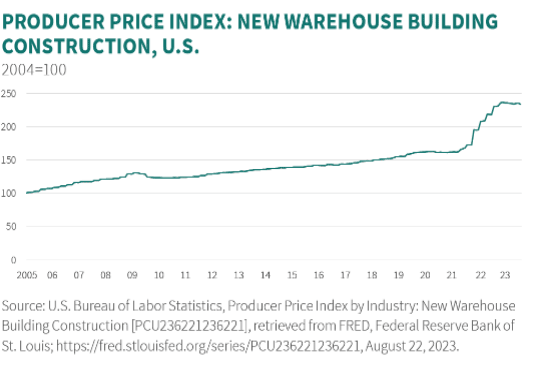The last several years have certainly been good for warehouse developers and builders, with all-time records for lowest vacancy rates overall and in many individual markets, lease rates rising sharply, new construction numbers strong and more.
So where are things headed for both supply and demand.
Supply Chain Digest Says... |
|
|
The research arm of warehouse developer Prologis tries to answer that question and more, identifying what it sees as four key global trends that will impact the market over the next few years.
The first trend, Prologis says, is that logistics real estate cycles will become less volatile due to a “multiplier effect” on demand and structural discipline in supply.
The report notes, for example, that for every dollar of US gross domestic product, at least 20% more logistics space is needed than was the case before the COVID-19 pandemic.
Why? First, Prologis notes that “US economic activity has shifted toward more logistics real estate-intensive uses over time.”
What’s more, the report says on average companies are maintaining higher inventory levels than before the pandemic, as frequent disruptions have led many to pull back from just-in-time strategies.
In addition, Prologis says that Increased product variety will drive the need for more storage space to service each unit of consumption, increasing demand for storage space.
More goods consumption is also a factor, with the report predicting that estimate goods will make up approximately 38% of US consumption going forward as millennials enter peak spending years, down from a pandemic high of 40% but above the pre-pandemic share of 36%.
As a final factor impacting demand for space, Prologis expects on-line’s share of goods spending will continue to increase (from 15% in 2019 to 25% by 2025. That in turn will continue to drive the need for more space because e-commerce fulfillment requires about three times the logistics space compared to brick-and-mortar retail, Prologis says.
In trend 2, Prologis says future logistics real estate cycles will also be less volatile because of the persistent discipline in new supply.
That’s in part due to the fact that barriers to building supply are high and rising. Prologis says the amount of developed land within 20 miles of US major city centers increased by 32% during the past 20 years as cities increasingly built outward. At the same time, regulatory barriers to new industrial buildings have increased, lengthening construction timelines, increasing costs and limiting the amount of new space brought on-line each year.
(See More Below)
|
CATEGORY SPONSOR: SOFTEON |
|
|
| |
|
|
However, somewhat contradictorily, the report also notes that delivery timelines are continuing to fall, with the ability to consistently deliver goods in one day or less becoming a competitively. Prologis says “Investments in larger, decentralized distribution networks facilitate fast delivery and reduce transportation costs. As a result, we expect increased demand for logistics real estate concentrated near centers of consumption.”
The third trend cited by Prologis is a growing focus on supply chain resilience.
The general move away from just-in-time inventory strategies to buffer against disruptions is a big driver of demand for warehouse space. Prologis notes that from 2020 to 1H 2023, US logistics real estate demand total 1.2 billion square feet or 330 million square feet (MSF) per year versus historical expansionary average of 175 to 200 MSF in the top 30 markets, demonstrating this incremental increase in demand.
Prologis also says that use of diversified sourcing and ports of entry will drive the need for duplicative facilities.
Finally, the fourth trend cited by Prologis is that new warehouse building deliveries will contract by 35% or more in the US and Europe in 2024.
With reduced supply, it is likely that market vacancies will move further below historical norms in late 2024 and into 2025 – not good news for shippers.
Construction costs remain elevated, Prologis says, driven by higher financing costs and competition for labor and materials from infrastructure, manufacturing and housing. Construction loans are now expensive and difficult to secure. With most banks tightening lending standards and interest rates doubling during the past 18 months, the era of ample, low-cost financing ended abruptly in 2022. (See graphic below.)
New Warehouse Construction Costs Took off in 2021

Source: Prologis
All told, Prologis concludes, “users of mission-critical logistics facilities, structural shifts in demand, like evolving consumer preferences and the need for supply chain flexibility in an increasingly uncertain world, are more likely to be met with chronic undersupply and higher barriers to new development in the future.”
Do you have any thoughts on these warehouse space trends? Let us know your thoughts at the Feedback button below (email) or in the Feedback section.
|